
Meetings supported by VarSITI and its projects in 2015
REPORTS
International Study of Earth-affecting Solar Transients (ISEST/MiniMax24) Workshop, 2-5 November 2015,
National Autonomous University, Mexico
Solar Variability and its Heliospheric Effects, 2-6 November 2015, Athens, Greece
Conference on Sun-Climate Connections, 16-19 March 2015 Kiel Germany
The 2nd annual conference of Nigerian Geophysical Society (NGS), 17-20 March, 2015,
Covenant University, Ogun State, Nigeria
26th General Assembly of IUGG, June 22-July 2, 2015, Prague, Czech Republic
Symposium A15: and Symposium A16:
Meeting on Superflares and Activity of the Sun in the Cycle Formation Epoch,
28 April-1 May 2014 Katsrin & Tel Aviv Israel
ISAR-4, Session A4: Geospace over and related to the Arctic region, April 27-30, 2015 Toyama Japan
SCOSTEP-WDS Workshop- “Global Data Activities for the Study of Solar-Terrestrial Variability”,
28-30 September 2015 Tokyo Japan
Workshop “Unsolved Problems in Magnetospheric Physics” (UPMP), 6-12 September 2015, Scarborough, UK
International School on Equatorial and Low-Latitud Ionosphere, ISELLI, 14-18 September 2015 Abuja, Nigeria
2015 African Geophysical Society Conference, 21–25 September 2015 Nairobi Kenya
Coimbra Solar Physics Meeting "Ground-based Solar Observation in the Space Instrumentation Era",
5-9 October 2015, Coimbra Portugal
VarSITI Newsletter Vol.8
International Study of Earth-affecting Solar Transients (ISEST/MiniMax24) Workshop
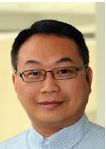 Jie Zhang
Jie Zhang
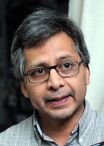 Alejandro Lara
Alejandro Lara
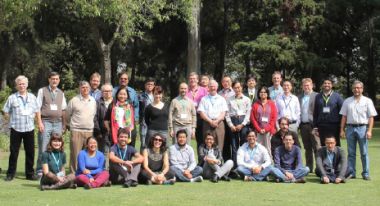 Group photo of the participants.
Group photo of the participants.The annual ISEST International Workshop in 2015 was held in Univeridad Nacional Autonoma de Mexico, México City, Mexico, October 26–30, 2015. The ISEST, one of the four SCOSTEP/VarSITI projects, is aimed at bringing together scientists from different countries to interact and establish collaboration links that can effectively address the physical mechanisms of the origin, propagation, and Earth impact of solar transient events, including coronal mass ejections (CMEs), solar energetic particle events (SEPs) and corotating interacton regions (CIRs). About 40 experts and students from nine countries participated in this workshop, making seven invitation and 31 contributed talks. Leaders from all seven Working Groups (data-1, theory-2, simulation-3, campaign-4, Bs challenge-5, SEP-6 and MiniMax24-7) made progress reports in the beginning and summary reports in the end of the workshop. Rigorous and fruitful discussons were a trademark of the five-day-long workshop. All presentations and WG reports, along with data products, are archived and publicly available at the ISEST WIKI Website at “http://solar.gmu.edu/heliophysics/index.php/Main_Page”.
Solar Variability and its Heliospheric Effects,
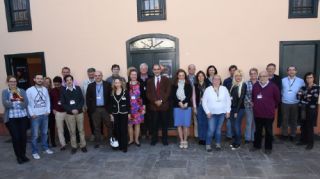 Group photo of participants
Group photo of participants
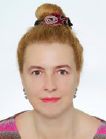 Olga Malandraki
Olga Malandraki
This international conference took place in Athens from 2-6 November 2015. The conference was or-ganized under the auspices of IAASARS of the Na-tional Observatory of Athens. 45 scientists attended the conference. In total 35 papers, with 31 Oral (Invited/Contributed) and 4 posters were presented. The meeting was co-sponsored by SCOSTEP/VarSITI. The conference was the 6th one organized in the frame of the Balkan, Black Sea and Caspian Sea Regional Network on Space Weather Studies comprising 11 countries. Many stimulating discus-sions took place for the various topics addressed.
The presentations covered various aspects of Solar-Terrestrial Research and Space Weather relevant to the scientific goals of SEE and the other VarSITI projects: the Sun and solar activity, the solar wind and heliosphere, magnetospheric and ionospheric research advances, solar influences on the middle and lower atmosphere and the climate, space weather forecasting anframe of the d services. Many young scientists participated as well as targeted invited scientists from the international community (e.g. USA, Germany, Belgium). Presenting materials of the papers have been linked to the final programme: http://www.space.noa.gr/bbc-sws/programme/
 Thierry
de Wit
Thierry
de WitUniversity of Orléans
VarSITI Newsletter Vol.5
Conference on Sun-Climate Connections
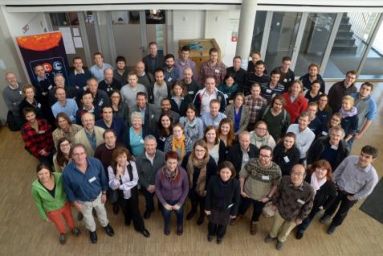 Group photo of the participants.
Group photo of the participants.Over 90 participants attended the Sun-Climate Connections (SCC) conference, which addressed recent advances in our understanding of the multiple connections between solar variability, and the Earth’s climate. This meeting provided new insight into several issues, such as the impact of energetic electrons precipitating into the atmosphere, the role of the global electric circuit, and the modelling of the ozone response to solar variability. The programme included a panel discussion with members from the broader climate community. This discussion highlighted the role of multidisciplinary interactions, the need for better including the various solar forcings in climate system studies, but also the importance of having a framework for pursuing such studies on the longer term. One day was also devoted to outreach activities, including a public debate; a team of highly motivated young scientists took care of 70 high school students, debating with them the causes of global warming, discussing solar impacts, and showing auroras on a Planeterrella aurora simulator.
VarSITI Newsletter Vol.5
The 2nd annual conference of
Nigerian Geophysical Society (NGS)
 Elijah Olukayode Falayi
Elijah Olukayode Falayi
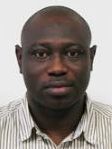 Olawale Segun Bolaji
Olawale Segun Bolaji
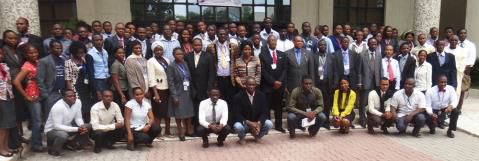
Figure 1. Group photograph taken immediately after the opening program of the NGS 2015.
NGS is a dynamic, innovative, and interdisciplinary international scientific association committed to the pursuit of understanding of Earth and Space Science. The 2nd annual conference held at Covenant University (CU), ota, Nigeria (March 17-20, 2015) titled the role of the Earth and its Atmosphere on our Technology. 102 participants registered and participated in the conference; include experts, upcoming scientists, postgraduate students and undergraduate students, from 21 Nigerian universities and agencies with a participant from Ivory Coast, a West African country. The meeting was successful with 24 oral presentations bringing together new ground measurement results and modeling studies. The conference breaks new ground of discussion between experts, upcoming scientists and postgraduate students.
We at NGS thank CU, Scientific Committee on Solar-Terrestrial Physics (SCOSTEP)/Variability of the Sun and its Terrestrial Impact (VarSITI), National Space Research and Development Agency (NASRDA) and Atmospheric and Space Environment Research Network (ASPERN) for their supports, which make the con-ference a successful one.
VarSITI Newsletter Vol.6
26th General Assembly of IUGG
Symposium A15:
“Long-term trends in the stratosphere, mesosphere, thermosphere, and ionosphere”
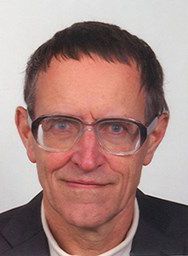 Jan Lastovicka
Jan LastovickaInstitute of Atmospheric Physics, Prague, Czech Republic
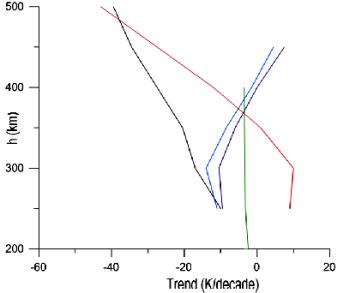
Figure 1. Height profiles of trends of Ti at MillstoneHill (black noon; red – midnight; Zhang and Holt, 2013), of noontime Ti at EISCAT (light blue with MgII, black-blue with F10.7; Ogawa et al., 2014), and green of Tn at noon (Solomon et al.,2015).
12 oral papers (including 4 solicited) and 10 posters were presented at this well-attended symposium (>50 participants) co-org-anized by the SCOSTEP/VarSITI/ROSMIC WGs3 and WGs4. The symposium brings interesting new results, among others: Midlatitude ozone recovers to the 1980 level in coming decades, Atlantic ozone in the mid-2100, and equatorial ozone never due to acceleration of the Brewer-Dobson circulation of greenhouse gas origin (Hegglin). Trends in the mesopause region winds changed substantially in the mid-1990, probably in response to change in ozone trend (Jacobi). Measurements by SABER and ACE/FTS show that trends in CO2 concentration are remarkably increasing with height in 80-110 km (Rezac). Model GAIA provides trends of neutral temperature Tn in the thermosphere, which are below ~300 km in reasonable agreement with observed trends in ion temperature Ti (Miyashi). However, Ti trends at altitudes above 300 km differ principally up to sign (see Figure)
VarSITI Newsletter Vol.6
26th General Assembly of IUGG
Symposium A16:
“Energetic Particle Precipitation into the Atmosphere: Sources and Atmospheric Impacts”
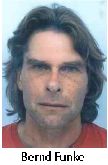 Instituto de Astrifìsica de Andalucia, CSIC, Granada, Spain
Instituto de Astrifìsica de Andalucia, CSIC, Granada, Spain
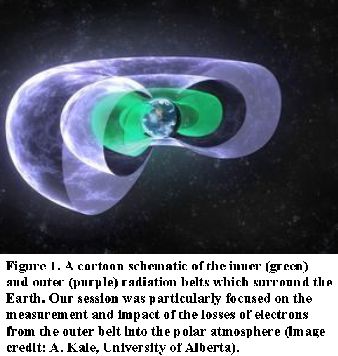
The symposium was held at the 26th IUGG General Assembly in Prague on 26 June 2015. The sixteen oral and three poster presentations addressed the precipitation drivers, the nature of the particle fluxes, and the impact of the precipitation on the ionosphere or atmosphere by means of satellite/ground-based and experimental observations, as well as theoretical investigations. A particular focus was given to observations of particle fluxes and atmospheric chemical changes caused by energetic particles, as well as approaches showing how electron precipitation impacts can be applied by the atmospheric community. These topics are of high relevance for VarSITI’s ROSMIC and SPeCIMEN Projects. Invited speakers were Ethan Peck (USA) who reported on his work on improving the use of POES electron fluxes, and Monika Andersson (Finland) who presented her work on OH and O3 variations induced by energetic electron precipitation in the mesosphere, recently published in Nature Communications. Speakers in the session ranged from Europe, North America, South America and Oceania. It was notable that the audience included scientific leaders from both the radiation belt and atmospheric community, and that the audience stayed right to the end of the final talk despite refreshments having started outside ~15min beforehand.
VarSITI Newsletter Vol.6
Meeting on Superflares and Activity of the Sun in the Cycle Formation Epoch
 Lev Pustilnik
Lev Pustilnik
 Maria Katsova
Maria Katsova
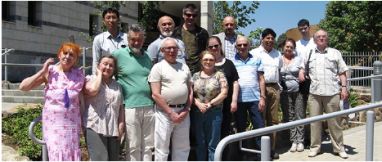 Group photo of the participants.
Group photo of the participants.At present, non-stationary phenomena of total energies up to 1000 times stronger than solar flares are found on solar-like stars. Such superflares occur more often on stars which are significantly younger than the Sun. This new observational information required joint efforts of astronomers in the field of heliophysics, stellar astrophysics and solarterrestrial connections in order to indentify the character of activity on the young Sun. The invited talks of participants from Germany, Japan, Russia, Finland, Hungary, and Israel presented reviews dedicated to an evolution of stellar activity, determination of ages of stars, observations and theory of superflares, spottedness of stars with activity cycles. Despite limited numbers of participants (20 scientists), very interesting debates on activity of the young Sun with participation of a few PhD students and postdocs were quite productive. Perspective investigations which are essential for study and forecast of the space weather and its effects on geo- and biosphere were discussed. The conference held in Golan Research Institute (Katzrin) and in Israel Cosmic Ray and Space Weather Center (Tel Aviv University), where several reviews dedicated the observational and theoretical aspects of the magnetic cycle on the Sun were presented. The site of the conference is: here.
VarSITI Newsletter Vol.6
ISAR-4, Session A4:
Geospace over and related to the Arctic region
 Group photo of the participants.
Group photo of the participants.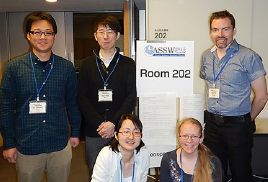 the recipients of travel support by VarSITI/ROSMIC
the recipients of travel support by VarSITI/ROSMIC
Many phenomena in the near-earth space environment (Geospace) significantly affect human activities and social infrastructures in the Arctic regions. In ISAR-4 of ASSW (Arctic Science Summit Week) 2015 of IASC under ICSU, held in Toyoma, Japan on April 23-30, 2015, a session entitled ‘Geospace over and related to the Arctic region (A4)’ was organized as an international forum to discuss recent progress in this area and to advance the operation and development of essential research infrastructures. Fifteen oral talks and fourteen posters were presented with more than 40 audience. An open side meeting was also held with 26 attendees, with short reports from each institution and short poster introductions. Most of the attendees continued fruitful discussions on recent progress and further collaborations in the following dinner party at a local restaurant. Five young scientists received partial travel support by the ROSMIC/VarSITI, and presented their papers.

Submitted by
SCOSTEP-WDS Workshop
“Global Data Activities for the Study of Solar-Terrestrial Variability”,
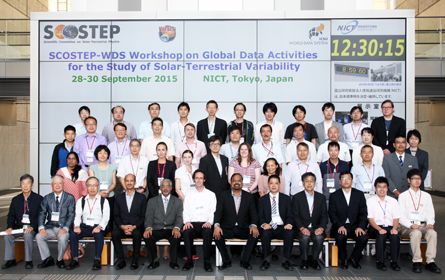
This Workshop was held in Tokyo at the National Institute of Information and Communications Technology (NICT) from 28 to 30 September 2015. In total, 51 papers (36 oral and 15 poster papers) were presented. Among these, 29 papers dealt with data-oriented activities (data systems, metadata networks, databases, data-oriented information technologies), and 20 data-analysis papers were presented to discuss solar-terrestrial phenomena with various time scales, including the St. Patrick’s Day 2015 and the Summer Solstice 2015 Events.
Presenting materials (PDF) of these papers have been linked to the final programme posted on the Workshop Web page (http://isds.nict.go.jp/scostep-wds.2015.org/index.html).
As an initial step of collaborations between SCOSTEP and WDS on data activities of VarSITI, a Letter of Agreements (LoA) was signed during the Workshop by which SCOSTEP becomes a formal Partner Member of WDS (https://www.icsu-wds.org/).
Papers relevant to this Workshop are planned to be published in a special issue of the Earth, Planet and Space (EPS, http://www.earth-planets-space.org/). Beside of full papers and letters, technical reports of data systems, data bases and data management software can be included. Details will be announced in the Workshop Web page.
(ICSU-WDS International
Programme Office)
Reported by
Workshop “Unsolved Problems in Magnetospheric Physics” (UPMP),
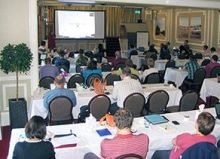
The workshop combined formal talks and discussions sessions in order to address unsolved problems in magnetospheric physics.
The “Unsolved Problems of Magnetospheric Physics Workshop” (sponsored by SCOSTEP/VarSITI) was held in Scarborough, UK from 6-12th September, 2015. The meeting was convened to assess our current state of knowledge regarding magnetospheric physics and solar-wind/magnetosphere interactions. 57 scientists attended the workshop. Over six days discussions centred on what we don’t know about the magnetosphere, rather than what we already do know. A Special Section of the JGR Space Physics on “Unsolved Problems in Magnetospheric Physics” will be open for paper submission from 1st October 2015 to 1st February 2016. More information regarding the meeting can be found at http://spacescience.org/upmpw/.
The workshop is the fourth in a series of meetings previously held in Chile and the USA. We are already looking forward to the next meeting in the series - to be held in Chile in the autumn of 2017!
Space Science Institute, Boulder, CA, USA
New Mexici Consortium, Los Alamos, NM, USA
Reported by
2015 African Geophysical Society Conference,
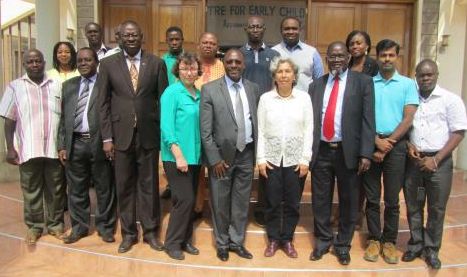
Participants of 2015 AGS Conference.
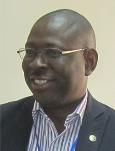 Babatunde Rabiu
Babatunde Rabiu
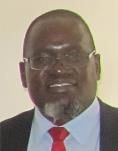 Paul Baki
Paul Baki
The 2015 Annual Conference of AGS took place
at the Kenya Institute of Curriculum Development, Nairobi, Kenya, between 21st and 25th September 2015. The conference featured conferment of
AGS fellowship award on six (6) eminent scientists for their enormous contributions to the development
of Earth and Space Science in Africa. Twenty two (22) participants attended the 2015 AGS conference from
3 African Countries (Nigeria, Kenya and South Africa), France and India. 22 papers were presented
as follows: 5 plenary papers; 15 orals and 2 posters. Technical sessions covered in the conference were:
Solid Earth & Ocean Sciences; Atmospheric Science; Astronomy and Planetary Science; Solar and
Terrestrial Science (Equatorial ionospheric dynamics, Space weather, VarSITI: SCOSTEP new scientific activity); Hydrological Science, Space weather
effects on GNSS application at equatorial latitudes ;
Earth & Space Science Informatics ESSI; and Science/Applications of SBAS/EGNOS in Africa. Participants had close interaction and exchange ideas
during the Conference which was supported by the Centre for Atmospheric Research, National Space
Research & Development, Nigeria and SCOSTEP/VarSITI. The 2016 AGS conference is scheduled for Abidjan, Cote D’Ivoire in November 2016.
Check www.afgps.org for details.
Reported by Babatunde Rabiu and Paul Baki
Coimbra Solar Physics Meeting "Ground-based Solar Observation in the Space Instrumentation Era",
 Group photo of participants
Group photo of participants
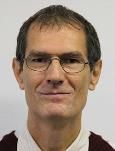 Ivan Dorotovič
Ivan Dorotovič
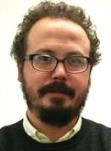 Joäo Fernandes
Joäo Fernandes
The second Coimbra Solar Physics Meeting was held in the University of Coimbra (Portugal) during 5 – 9 October, 2015, for discussing the state-of-art solar ground-based and space-based observing techniques and related topics. Total of 56 oral contributions (including 21 invited) and 42 posters were presented at this well-attended meeting (91 participants) co-sponsored by the SCOSTEP/VarSITI. The LOC partially supported from this sponsorship 13 mostly young participants. The CSPM-2015 scientific meeting (http://www.mat.uc.pt/~cspm2015/overview.html) covered various aspects of solar dynamic and magnetic phenomena which are observed over the entire electromagnetic spectrum. Emphasis was placed on instrumentation, observing techniques, and solar image processing techniques, as well as theory and modelling through detailed radiative transfer in increasingly realistic MHD models. Many young scientists are familiar with ground based instruments and data, so this was an opportunity for them to participate in international efforts for mutual scientific benefit.
Reported by Ivan Dorotovič and Joäo Fernandes
International School on Equatorial and Low-Latitud Ionosphere, ISELLI
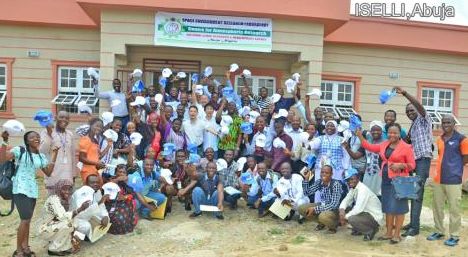 Participants of ISELLI.
Participants of ISELLI.
 Kazuo Shiokawa
Kazuo Shiokawa
 Babatunde Rabiu
Babatunde Rabiu
The International School on Equatorial and Low- Latitude Ionosphere (ISELLI) was held at Abuja, Nigeria on 14-18 September 2015. Participants are 65 students from 7 countries from Nigeria, Rwanda, Kenya, Egypt, Cote D'Ivore, Tanzania, and Brazil. Thirteen (13) lecturers from Japan and Nigeria introduced ionospheric dynamics, measurement techniques, Spread-F/plasma bubbles, and space weather. A visit of observatory to see a MAGDAS fluxgate magnetometer and an OMTI all-sky airglow imager was held on Thursday. Participants enjoyed lively discussions with the lecturers and mutual communications during this one-week school. This school was supported by Centre for Atmospheric Research (CAR), Solar-Terrestrial Environment Laboratory (reorganized to ISEE from Oct. 1, 2015) of Nagoya University, JSPS core-to-core program B. Asia-Africa Science Platforms, Japan, International Center for Space Weather Science and Education (ICSWSE) of Kyushu University, and SCOSTEP's Capacity Building program.
Reported by Kazuo Shiokawa and Babatunde Rabiu